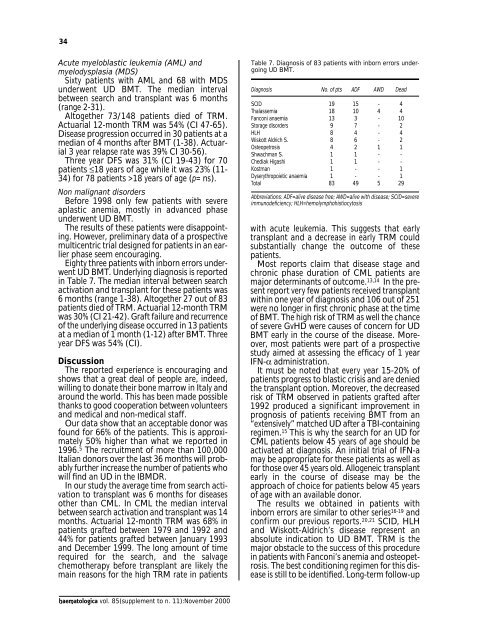Journal of Hematology - Supplements - Haematologica
Journal of Hematology - Supplements - Haematologica
Journal of Hematology - Supplements - Haematologica
Create successful ePaper yourself
Turn your PDF publications into a flip-book with our unique Google optimized e-Paper software.
34<br />
Acute myeloblastic leukemia (AML) and<br />
myelodysplasia (MDS)<br />
Sixty patients with AML and 68 with MDS<br />
underwent UD BMT. The median interval<br />
between search and transplant was 6 months<br />
(range 2-31).<br />
Altogether 73/148 patients died <strong>of</strong> TRM.<br />
Actuarial 12-month TRM was 54% (CI 47-65).<br />
Disease progression occurred in 30 patients at a<br />
median <strong>of</strong> 4 months after BMT (1-38). Actuarial<br />
3 year relapse rate was 39% CI 30-56).<br />
Three year DFS was 31% (CI 19-43) for 70<br />
patients ≤18 years <strong>of</strong> age while it was 23% (11-<br />
34) for 78 patients >18 years <strong>of</strong> age (p= ns).<br />
Non malignant disorders<br />
Before 1998 only few patients with severe<br />
aplastic anemia, mostly in advanced phase<br />
underwent UD BMT.<br />
The results <strong>of</strong> these patients were disappointing.<br />
However, preliminary data <strong>of</strong> a prospective<br />
multicentric trial designed for patients in an earlier<br />
phase seem encouraging.<br />
Eighty three patients with inborn errors underwent<br />
UD BMT. Underlying diagnosis is reported<br />
in Table 7. The median interval between search<br />
activation and transplant for these patients was<br />
6 months (range 1-38). Altogether 27 out <strong>of</strong> 83<br />
patients died <strong>of</strong> TRM. Actuarial 12-month TRM<br />
was 30% (CI 21-42). Graft failure and recurrence<br />
<strong>of</strong> the underlying disease occurred in 13 patients<br />
at a median <strong>of</strong> 1 month (1-12) after BMT. Three<br />
year DFS was 54% (CI).<br />
Discussion<br />
The reported experience is encouraging and<br />
shows that a great deal <strong>of</strong> people are, indeed,<br />
willing to donate their bone marrow in Italy and<br />
around the world. This has been made possible<br />
thanks to good cooperation between volunteers<br />
and medical and non-medical staff.<br />
Our data show that an acceptable donor was<br />
found for 66% <strong>of</strong> the patients. This is approximately<br />
50% higher than what we reported in<br />
1996. 5 The recruitment <strong>of</strong> more than 100,000<br />
Italian donors over the last 36 months will probably<br />
further increase the number <strong>of</strong> patients who<br />
will find an UD in the IBMDR.<br />
In our study the average time from search activation<br />
to transplant was 6 months for diseases<br />
other than CML. In CML the median interval<br />
between search activation and transplant was 14<br />
months. Actuarial 12-month TRM was 68% in<br />
patients grafted between 1979 and 1992 and<br />
44% for patients grafted between January 1993<br />
and December 1999. The long amount <strong>of</strong> time<br />
required for the search, and the salvage<br />
chemotherapy before transplant are likely the<br />
main reasons for the high TRM rate in patients<br />
Table 7. Diagnosis <strong>of</strong> 83 patients with inborn errors undergoing<br />
UD BMT.<br />
Diagnosis No. <strong>of</strong> pts ADF AWD Dead<br />
SCID 19 15 - 4<br />
Thalassemia 18 10 4 4<br />
Fanconi anaemia 13 3 - 10<br />
Storage disorders 9 7 - 2<br />
HLH 8 4 - 4<br />
Wiskott Aldrich S. 8 6 - 2<br />
Osteopetrosis 4 2 1 1<br />
Shwachman S. 1 1 - -<br />
Chediak Higashi 1 1 - -<br />
Kostman 1 - - 1<br />
Dyserythropoietic anaemia 1 - - 1<br />
Total 83 49 5 29<br />
Abbreviations: ADF=alive disease free; AWD=alive with disease; SCID=severe<br />
immunodeficiency; HLH=hemolymphohistiocytosis<br />
with acute leukemia. This suggests that early<br />
transplant and a decrease in early TRM could<br />
substantially change the outcome <strong>of</strong> these<br />
patients.<br />
Most reports claim that disease stage and<br />
chronic phase duration <strong>of</strong> CML patients are<br />
major determinants <strong>of</strong> outcome. 13,14 In the present<br />
report very few patients received transplant<br />
within one year <strong>of</strong> diagnosis and 106 out <strong>of</strong> 251<br />
were no longer in first chronic phase at the time<br />
<strong>of</strong> BMT. The high risk <strong>of</strong> TRM as well the chance<br />
<strong>of</strong> severe GvHD were causes <strong>of</strong> concern for UD<br />
BMT early in the course <strong>of</strong> the disease. Moreover,<br />
most patients were part <strong>of</strong> a prospective<br />
study aimed at assessing the efficacy <strong>of</strong> 1 year<br />
IFN-α administration.<br />
It must be noted that every year 15-20% <strong>of</strong><br />
patients progress to blastic crisis and are denied<br />
the transplant option. Moreover, the decreased<br />
risk <strong>of</strong> TRM observed in patients grafted after<br />
1992 produced a significant improvement in<br />
prognosis <strong>of</strong> patients receiving BMT from an<br />
“extensively” matched UD after a TBI-containing<br />
regimen. 15 This is why the search for an UD for<br />
CML patients below 45 years <strong>of</strong> age should be<br />
activated at diagnosis. An initial trial <strong>of</strong> IFN-a<br />
may be appropriate for these patients as well as<br />
for those over 45 years old. Allogeneic transplant<br />
early in the course <strong>of</strong> disease may be the<br />
approach <strong>of</strong> choice for patients below 45 years<br />
<strong>of</strong> age with an available donor.<br />
The results we obtained in patients with<br />
inborn errors are similar to other series 16-19 and<br />
confirm our previous reports. 20,21 SCID, HLH<br />
and Wiskott-Aldrich’s disease represent an<br />
absolute indication to UD BMT. TRM is the<br />
major obstacle to the success <strong>of</strong> this procedure<br />
in patients with Fanconi’s anemia and osteopetrosis.<br />
The best conditioning regimen for this disease<br />
is still to be identified. Long-term follow-up<br />
haematologica vol. 85(supplement to n. 11):November 2000

















